Integrated report 2019

Dear shareholder
A key responsibility of our role as a remuneration committee is to ensure that Exxaro remains aligned in its remuneration offering with evolving best fit remuneration standards and practices. It is a continuous challenge that we accept open-heartedly while ensuring that we apply the utmost rigour in our deliberations, striving for fair remuneration outcomes. Fairness and ethics are part of our culture and therefore cornerstones in our remuneration offering, extending from executive management to bargaining unit employees
2018 shareholder vote
We are concerned with the dwindling support received for the 2018 remuneration report:
 |
Approval of the remuneration policy for 2018: 73.09% (2017: 82.9%). |
 |
Approval of the implementation of remuneration policy for 2018: 76.38% (2017: 83.3%). |
It is for this reason, as well as the JSE Listings Requirements, that we engaged more extensively with shareholders so that we could understand their concerns. Various well-attended engagement sessions were held during October 2019 by the remuneration committee chairman, and the chairman of the board with a broad base of our shareholders and investors.
Following these sessions, the remuneration committee deliberated on all the issues raised, and endeavoured to address them through a combination of additional disclosure, and remuneration policy changes in the short, medium and longer term. We were able to incorporate some of the concerns raised in the current cycle or by providing further disclosure. Other concerns will take longer to be reflected visibly in the reward outcomes. As a response, we have summarised the key shareholder feedback points and provided responses in the table below on how the issues raised have been or will be addressed:
| Shareholder concerns raised | Exxaro's response | ||
| General: Disclosure on pay for performance alignment | |||
| Improved disclosure of performance metrics used for CEO and finance director and the weight allocation to financial and non-financial metrics. | Forward-looking performance priorities for CEO and finance director are now disclosed, indicating metrics and weights. | ||
| Improved disclosure of short-term incentive (STI) and long-term incentive plan (LTIP) metric weights, and performance conditions at threshold, target and stretch. | Now more clearly disclosed. | ||
| The weight allocation to performance metrics, should be reflective of its relative importance in strategy. | Adjustments to this effect have been made. | ||
| A malus and clawback policy should be adopted. | A decision was taken by the board to include a malus and clawback policy for 2020 awards on both STI and LTIP. | ||
| Long-term incentive related | |||
|
A return-based measure such as return on capital employed (ROCE) is preferred over headline earnings per share (HEPS). |
ROCE replaces HEPS as a performance vesting condition for the 2020 LTIP awards. | ||
| Disclose total shareholder return (TSR) peer group for the LTIP. | Now disclosed in the remuneration report. | ||
| Specify environmental, social and governance (ESG) performance targets for the LTIP scheme. | Disclosed as part of the LTIP performance vesting conditions. | ||
| Preference for a five-year vesting period rather than a three-year vesting period was expressed. | We will continue with a three-year vesting period while adoption of minimum shareholding requirements is considered during 2020. | ||
| Minimum shareholding requirement for prescribed officers to be considered. | Under review in 2020. | ||
| Short-term incentive related | |||
|
Consider consolidating special performance reward (SPR) and STI into one scheme. |
Under consideration for the 2021 cycle. |
The remuneration policy and accompanying implementation report are tabled in two separate resolutions every year for non-binding advisory votes by shareholders at the annual general meeting (AGM). Shareholders are required to express their views and vote on the remuneration policy and its implementation.
If either the remuneration policy or accompanying implementation report are voted against by 25% or more of the voting rights exercised, the committee will again engage with significant shareholders to ascertain reasons for dissenting votes. Legitimate objections and concerns will be addressed. Possible recourse could include amending the remuneration policy, as well as clarifying or adjusting remuneration governance and processes.
The 2019 financial period has proven to be a challenging year on a number of fronts. The coal mining industry has come under increasing pressure due to environmental threats and, as a result, lost some favour with the investment community. Nevertheless, the group performed well in terms of its strategic and operational objectives.
The group has continued to respond to these sustainability challenges in redefining the strategy of the business in favour of longer-term sustainable business initiatives
We acquired the remaining 50% ownership of our renewable
energy investment in Cennergi. Our efforts in ESG continue
to deliver ongoing improvements in our carbon footprint and
water management ( ![]() see our Climate change and carbon footprint and Water management).
see our Climate change and carbon footprint and Water management).
In addition, we have had success in our initiatives to grow skills and competencies within our workforce so that our people are equipped to meet the requirements of jobs in the business of the future when the fourth industrial revolution will require enhanced digital skills. As we embrace diversity and inclusion, our initiatives to increase female representation, and ensure representation of disadvantaged groups in the workforce, are also bearing positive results.
As a consequence of the nature of the industry in which we operate, the group is exposed to iron ore and coal commodity prices. The sharp drop in the price of thermal and export coal, together with local inflationary pressures, impacted the ability of business units to achieve their net operating profit (NOP) targets. In some production units, the challenges associated with increased production volume targets also affected their ability to meet short-term incentive targets.
Exxaro was able to advance its key objectives for safety, portfolio optimisation, operational excellence and capital allocation during 2019. As a responsible corporate citizen, we remain resolute in striving to achieve zero harm for our people, while increasing efficiencies
The remuneration committee, in assessing the CEO as well as overall group performance, has concluded that Exxaro is led by a dedicated executive team who function well and have delivered a robust set of business results against the priorities for the current cycle. Delivery against key business initiatives and key performance indicators are the underlying drivers of our variable pay schemes highlighted below:
| Safety | Sustainability | Procurement | Operational excellence performance |
Leadership, people and culture initiatives |
||||
| Our LTIFR regressed slightly as we missed our targeted improvement. We were able to maintain our fatality free record and extend it to a continuous period of 33 months (three years to end of March 2020). Our safety campaign, Khetha Ukuphepha (choose safety) was able to correct a temporary safety performance decline during the year. | We achieved an excellent rating from FTSE Russell for combined sustainability and continue to improve our rating in the top quartile compared to our peers. | Preferential procurement from designated groups reflects an achievement that is better than the Mining Charter requirements. | Indicators such as rand/tonne/product group came under pressure and missed the target. | We excelled in culture change initiatives and have focused on specific mechanisms to ensure that we reach our targets as set out in our employment equity plans. |
Management’s SPR and performance contracts include delivery against sustainable strategic objectives as well as the operational performance objectives of respective business units. The 2019 business performance results were reflected in the STI schemes results with reduced reward payments when compared with the previous cycle:
Of the LTIP awards made in April 2017, overall, 92.3% of the awards will vest due to 76.9% of the ESG (33.34% weight) component vesting. For the HEPS and TSR components (33.33% weight each), 100% of awards will vest.
Notable matters and key focus areas of the committee during the review period included:
Strategic workforce planning
|
|
|
Training and development
|
|
|
Talent planning
|
|
Exxaro continues to seek independent and professional advice on remuneration matters. In the review period, we were advised by consultants who, in the view of the committee, could be regarded as fully independent:
Various changes are contemplated to the remuneration policy during 2020, as we realign our remuneration policy to enable implementation of our future business strategy. Our remuneration policy will continue to evolve by embedding applicable best fit market practices. Implementation of the new ESOP scheme in 2020 will continue to foster a culture of ownership and provide a mechanism to share the longer-term shareholder gains with all employees.
In addition to the normal work plan, the committee will focus specifically on the following areas in 2020:
I thank my fellow committee members for their support and wise counsel in the review period. I also thank the executive head of human resources and her team for their hard work and dedication in ensuring Exxaro remains competitive in the market and an employer of choice for all of its employees.
EJ Myburgh
Chairman
Remuneration and nomination committee
20 April 2020
In this section, we provide a broad overview of the remuneration philosophy, principles and policies applicable to the various remuneration elements in terms of various employee groupings, including executive directors, prescribed officers, senior management and all other employees.
Inputs from our shareholder engagement process and the internal review of our remuneration policy resulted in changes recommended to the remuneration committee. We share a summary of these changes to the remuneration policy applicable to executive directors and prescribed officers.
In the view of the committee, our remuneration philosophy underpins our strategy and enables us to achieve our business objectives. Our commitment to pay for performance in alignment with shareholder value creation drives all our remuneration activities and continues to deliver a sound value proposition to employees.
We strive to attract, retain and empower the best talent to achieve our strategy and create sustainable stakeholder value
Our vision for rewards is to provide simple, integrated, holistic solutions, common messages and a package differentiated from the market for Exxaro to attract, retain and energise talented, high-performing people.
Exxaro understands that remuneration is critical in attracting and retaining high-performing individuals. As such, the committee firmly supports the principle that pay must be aimed at reinforcing, encouraging and promoting superior performance.
We believe in the fair and responsible remuneration principles we have adopted to guide our policies directed at different remuneration elements in our remuneration framework.
The table below shows the remuneration offering used to reward employee categories in a fair and equitable manner.
The policy provides for an annual assessment of the wage gap and consideration of any appropriate actions such as differentiating annual adjustments. In addition, the principles of internal parity, reward for performance and market competitiveness apply. These principles facilitate fair and responsible remuneration.
Table 2: Remuneration offering by employee category
Remuneration
| Employee category* | Total guaranteed remuneration |
Variable pay | ||||||
|---|---|---|---|---|---|---|---|---|
| STI schemes | LTI schemes | |||||||
| Notional cost of employment (NCOE) |
Basic salary and benefits |
STI | SPR | LTIP | Deferred bonus plan (DBP)** |
ESOP | ||
| Executive management (F band) | x | x | x | x | x | |||
| Senior management (E band) | x | x | x | x | x | |||
| Middle management (D upper and middle bands) | x | x | x | x | ||||
| Junior management (D lower and C upper bands) | x | x | x | |||||
| Bargaining unit employees (C middle to A bands) | x | x | x | |||||
| * | The Paterson job grades are indicated by applicable employee category. |
| ** | DBP excludes E lower grade. |
The table below indicates the maximum percentage of total guaranteed remuneration applicable to the variable pay schemes, by grade. The remuneration mix is benchmarked on an annual basis prior to the granting of annual long-term incentive (LTI) awards.
Table 3: Remuneration mix on variable pay by Paterson grade at maximum (expressed as a percentage of total guaranteed remuneration)
| Grade | Maximum STI (%) |
Maximum SPR (%) |
Maximum STI schemes (%) |
Maximum LTIP (%) |
Maximum DBP* (%) |
Maximum LTI schemes (%) |
Maximum total variable pay (%) |
|||||
|---|---|---|---|---|---|---|---|---|---|---|---|---|
| F upper | 18.33 | 37.00 | 55.33 | 231.00 | 27.39 | 258.39 | 313.72 | |||||
| F lower | 18.33 | 32.00 | 50.33 | 143.00 | 24.91 | 167.91 | 218.24 | |||||
| E upper | 18.33 | 25.00 | 43.33 | 101.00 | 21.45 | 122.45 | 165.78 | |||||
| E middle | 18.33 | 20.00 | 38.33 | 76.00 | 10.54 | 86.54 | 124.87 | |||||
| E lower and D upper | 18.33 | 15.00 | 33.33 | 38.00 | 0.00 | 38.00 | 71.33 | |||||
| D middle | 18.33 | 10.00 | 28.33 | 38.00 | 0.00 | 38.00 | 66.33 | |||||
| D lower and below | 18.33 | 0.00 | 18.33 | 0.00 | 0.00 | 0.00 | 18.33 |
| * | The maximum DBP matched portion is 90% of the total after-tax STI schemes for F band and E-upper Paterson grades and 50% for E-middle Paterson grade. |
The table following provides an indication of the total variable pay due, by component, for achievement at target. The STI and SPR schemes explicitly state the target bonus quanta applicable at target. The LTIP performance vesting conditions are defined at maximum and threshold. In order to provide an indication of targeted total variable pay, target is considered halfway between threshold and maximum. In the case of the DBP, we applied the midpoint of the voluntary deferral, 50% to the target STI schemes.
Table 4: Remuneration mix on variable pay by Paterson grade at target (expressed as a percentage of total guaranteed remuneration)
| Grade | Target STI (%) |
Target SPR (%) |
Target STI schemes (%) |
Target LTIP (%) |
Target DBP* (%) |
Target LTI schemes (%) |
Target total variable pay (%) |
||||
|---|---|---|---|---|---|---|---|---|---|---|---|
| F upper | 8.33 | 33.30 | 41.63 | 150.15 | 11.45 | 161.60 | 203.23 | ||||
| F lower | 8.33 | 28.80 | 37.13 | 92.95 | 10.21 | 103.16 | 140.29 | ||||
| E upper | 8.33 | 22.50 | 30.83 | 65.65 | 8.48 | 74.13 | 104.96 | ||||
| E middle | 8.33 | 18.00 | 26.33 | 49.40 | 7.24 | 56.64 | 82.97 | ||||
| E lower and D upper | 8.33 | 13.50 | 21.83 | 24.70 | 0.00 | 24.70 | 46.53 | ||||
| D middle | 8.33 | 9.00 | 17.33 | 24.70 | 0.00 | 24.70 | 42.03 | ||||
| D lower and below | 8.33 | 0.00 | 8.33 | 0.00 | 0.00 | 0.00 | 8.33 |
| * | The target DBP matched portion is 50% of the total after-tax STI schemes for F band and E-upper Paterson grades and 50% for E-middle Paterson grade. |
Graph 1: Remuneration mix for CEO, finance director and prescribed officers
| CEO: Pay mix | FD: Pay mix | |
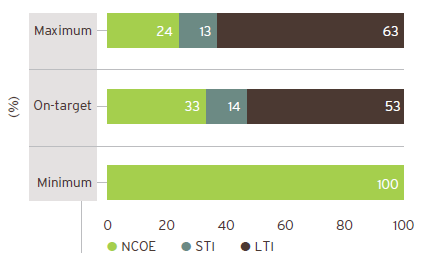 |
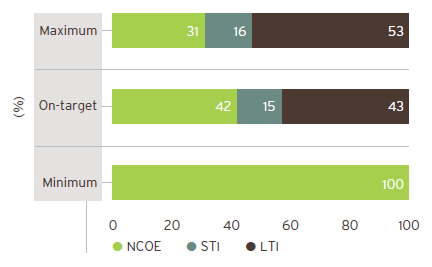 |
|
| Prescribed officer (on Patterson Band F — lower): Pay mix | Prescribed officer (on Patterson Band E — upper): Pay mix | |
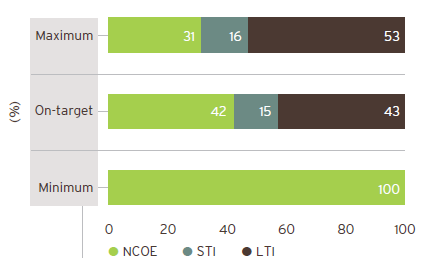 |
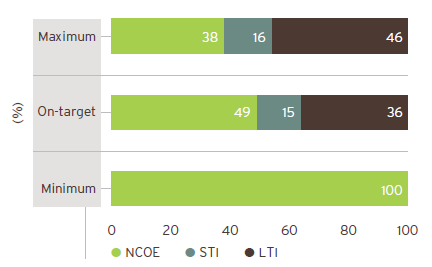 |
2.4.2 Total guaranteed remuneration
Our policy at Exxaro is to:
NCOE is the guaranteed remuneration portion of total pay and includes basic salary, benefits and retirement funding.
All bargaining unit employees receive a market-related basic salary complemented by guaranteed allowances (housing and commuting), variable allowances (shift and standby) as well as benefits (see full list of benefits below). Bargaining unit employees have received increases of between 0.5% and 1.5% per annum higher than management and specialist category employees over the past 14 years (2006 to 2020) to reduce the wage gap.
All employees are entitled to the same range of benefits appropriate to their role level and specific circumstances. Management and specialist employees have flexibility in structuring their remuneration within certain company and legislative limitations. During the year no changes were made to the applicable policies for retirement funds, medical health and other benefits stated below.
| Retirement funds | Medical health schemes | Group personal accident cover | ||
| All employees are members of one of Exxaro’s accredited retirement funds. Retirement fund contributions are determined by specific conditions of employment and fund rules for the different levels and categories of employees. | Employees may annually elect to belong to any of the accredited medical schemes as they apply to the relevant employees. Contributions are made by employer and employee. Exxaro does not provide any post-retirement medical benefits. The post-retirement benefit obligation disclosed in the annual financial statements recognises past practice (by Eyesizwe) that was discontinued with the creation of Exxaro in November 2006. |
Employees are beneficiaries of a policy that provides additional cover for death, disability and dread disease through group personal cover taken out by Exxaro. |
2.4.3 Variable pay
The STI schemes focus on annually contributing to the strategic goals and delivering Exxaro’s operational and financial objectives in the shorter term.
Exxaro has two STI schemes:
The SPR scheme applies to all permanent employees (DM Paterson grade and above) in the Exxaro Resources management and specialist category.
Participants in the scheme are required to have an SPR contract with individual SPR objectives for the 12-month period. It is evaluated twice a year and the final rating forms the basis for payment of the SPR scheme.
The SPR is measured on an annual basis and paid out in March of the following year. Once the SPR target has been achieved (three rating on a five-point rating scale), a potential of 90% will be paid out. Above-target achievement (four rating on a five-point scale) will qualify for a maximum of 100% payout. If target was not achieved (two or below on a five-point ratings scale), there will be no payout applicable to the employee.
The STI scheme applies to the Exxaro group and is based on business performance with two components: tier 1 and tier 2:
The STI is measured six-monthly for tier 1: January to June and July to December. It is paid out in August and February. Tier 2 is measured on an annual basis from January to December, and paid out in February. A business unit will qualify for tier 1 on a sliding scale between a threshold of 90% and 100% performance against targets. When the modifier kicks in, if 90% of target is achieved, no payout is applicable; if 95% of target is achieved, 4.165% of the potential 8.33% payout will be applicable; if 100% of target is achieved, 8.33% will be payable. If a business unit does not achieve 100% in tier 1, it will share in the tier 2 on the same percentage ratio achieved in tier 1. A sliding scale will also apply between improvement above 101% and 120%.
Table 5: STI scheme metric
| STI component | % of total guaranteed remuneration | Measures description | Threshold (0% of STI) | Maximum (100% of STI) | |||||
| 1 | 8.33 | Business unit and Coal CB | Business unit NOP vs target | 90 | 100 | ||||
| Corporate centre | Group NOP improvement above target | ||||||||
| 2 | 10.00 | Exxaro group | Group NOP above target | 100 | 120 |
Belfast’s incentive was based on ramp-up of operations while Ferroland Grondtrust, Coastal Coal and Arnot were measured on closure, execution plans and targets.
Junior management and bargaining unit employees at commercial and captive mines, who are directly involved in production, qualify for line-of-sight STIs. The schemes are based on coal production with modifiers for safety and attendance per mining section. Both these schemes work on a sliding scale with threshold and full performance targets. Participants in these schemes do not qualify for the standard STI schemes.
Our LTIs comprise a suite of offerings which align remuneration with longer-term shareholder expectations and outcomes. Exxaro makes general share offers to participants once a year in terms of the LTIP and the DBP. The Exxaro Mpower (2012) wound up on 31 May 2017. An interim cash scheme, with units linked to the group dividend payment was introduced. A new ESOP is planned to be implemented in 2020.
The remuneration committee makes a conditional award to qualifying employees from executive management, senior management and middle management.
The percentage of awards that will vest range between a lower boundary (threshold: 30%) and an upper boundary (maximum: 100%) depending on the level of performance. Proportional vesting is calculated for an actual performance result between threshold and maximum. A linear sliding scale is used between the threshold and maximum. For any actual performance below threshold, no awards will vest and for any performance at or exceeding the upper boundary, the awards that will vest are capped at 100%.
Awards vest after three years, subject to fulfilling the following performance conditions. For the 2019 awards, the performance conditions were as follows.
Table 6: LTIP vesting conditions
| Performance vesting condition | Weight (%) |
Threshold
(30% of awards vest) |
Maximum
(100% of awards vest) |
|||
| HEPS | 33.33 | Same as 2018 HEPS | CPI + 2% per annum (or 6% over the three-year period) | |||
| TSR | 33.33 | 7th position in TSR peer group | Top three positions of TSR peer group | |||
| ESG | 33.34 | Refer below | ||||
| The underlying metrics and performance vesting conditions at threshold and maximum for ESG are shown below | ||||||
| Safety: LTIFR | 11.34 | 0.15 | 0.12 | |||
| Reportable environmental incidents | 11.00 | Nine or less level 2 reportable incidents over the three-year period | No level 3 incidents over the three-year period | |||
| Governance: material compliance with King IIITM (and King IVTM where applicable) and full compliance with JSE Listings Requirements averaged over the three-year period | 11.00 | 95% compliance averaged over the three-year period |
100% compliance averaged over the three-year period | |||
Of the grant 33.33% will be the headline earnings per share (HEPS) improvement of the consumer price index (CPI) + 2% per annum (6% over the three-year performance period) compared to the HEPS of the basis year of the previous financial year. The lower performance condition will be the same as the base year’s HEPS and 30% of the LTIP will vest at this point. The upper performance condition will be equal to growth of CPI + 2% per annum (6% over the three-year performance period) over the three-year period and 100% of the LTIP will vest. A 30% to 100% sliding scale between the minimum and maximum will be applicable.
The remuneration committee will review the performance conditions in relation to the grant at the end of the performance period. Performance below the lower target will result in no vesting of LTIP.
The HEPS base will be the audited Exxaro financial results for the financial year.
The time period relating to the allocated conditional award is:
On the achievement of performance conditions, the vested awards must be exercised within seven working days from vesting.
Of the grant 33.33% will be compared to performance against the TSR peer group, namely the companies listed on the JSE RESI 10 index as at the preceding December of the offer.
The peer group listed companies included in the JSE RESI 10 index as at December 2018 included Anglo American, AngloGold Ashanti, Anglo Platinum, BHP Billiton, Gold Fields, Impala Platinum, Mondi, Sappi, Sasol, and Exxaro.
If any of the companies are removed from the JSE RESI 10 index, as a result of corporate action, only the remaining companies will be used and no reserves will be added.
The TSR of Exxaro for the purposes of this plan is defined as the compound annual growth rate (CAGR) on a portfolio of Exxaro ordinary shares purchased on December preceding the grant, holding the shares and reinvesting the dividends received from the portfolio in Exxaro shares until the end of the performance period, and then selling the portfolio on that day
The monthly TSR calculation will be performed using the dividend payments and Reuters share price data on the nearest trading day to 31 December preceding the grant and the nearest trading day to 31 December at the end of the performance period and computing the CAGR between these values.
The TSR will be smoothed by computing the TSR in the same manner for the three-year period following each trading month for the six-month preceding 31 December of the grant, which means that the TSR is computed from:
The TSRs computed in this manner will then be arithmetically averaged to yield the final “smoothed TSR” for the TSR performance condition.
The smoothed TSR for each member of the peer group will be computed over the same period in the same manner. This period of smoothing is in line with the market.
If the TSR of Exxaro over the three-year period is equal to the minimum TSR target, the minimum LTIP award (30% of the TSR portion of the grant) vests.
If the Exxaro TSR is equal to or greater than the maximum TSR target, then 100% of the grant will vest.
The award vests linearly between 30% and 100% for performance between the minimum TSR target and the maximum TSR target.
The TSR targets for the LTIP grant are:
The remuneration committee has the discretion to make adjustments to the method of computation of the TSR for the peer group and for Exxaro. Under the rules of the plan, the remuneration committee may vary the TSR condition if events occur that would make such a variation necessary or desirable or would make the amended performance condition a fairer measure of performance.
Of the performance condition 33.34% will be the achievement of ESG targets. The targets will be measured in terms of the approved strategic dashboard used to monitor achievement of the business strategy:
The remuneration committee selects participants, based on employee grouping and performance, from executive management and senior management. The scheme encourages share ownership while reinforcing retention.
Participants from F upper to E upper Paterson grades can elect to voluntarily use a portion (0, 50% or 90%) and E middle (50%) of their after-tax STI payments to acquire Exxaro shares at the prevailing market price.
Participants are entitled to all rights in respect of the shares (pledged), including dividends. If the pledged shares are held for the three-year pledged period, and participants remain in the employ of Exxaro for the same, Exxaro will provide a matching award on a one-for-one basis.
No performance vesting conditions are applicable to these awards.
A new ESOP was approved by the board in 2019 and will be implemented at the beginning of the second quarter of 2020 on completion of the consultation process with organised labour as well as the communication plan for employees.
Employees in the category DL and below will participate in the scheme, which provides individual employees dividend rights. Annually, a value equivalent to a dividend payment for a shareholder of 560 Exxaro shares will flow to each employee. Participants will remain in the scheme for the duration of employment. Employees will not have capital appreciation rights..
Executive employment contracts for management are generally valid for an indefinite period with a notice period of three to six months or payment in lieu thereof.
The current executive employment contracts do not have a restraint-of-trade clause but include confidentiality undertakings.
Employment contracts provide for the following payments on termination:
Note: No special agreements in place on severance packages for executive employees, except for AW Diedericks who applied for a TVP and is approved to exit at the end of 2021 as per the TVP rules.
Fees for non-executive directors are reviewed annually and independent data is used for benchmarking ( ![]() see below).
see below).
Fees are paid as a combination of retainer and fee per meeting in line with emerging market practice and company culture.
Recommendations are made to the remuneration committee and board for consideration, and then presented at the AGM for shareholder approval as a separate resolution.
The variable pay schemes will undergo further changes during 2020. Following shareholder engagement, we were able to make some changes to the variable pay schemes for the current cycle. Applicable changes will impact the performance-based reward outcomes for the executive directors and prescribed officers. The table below summarises the impact on applicable awards:
Table 7: Remuneration offering changes
| Change rationale | 2019 | Proposed 2020 change | ||
| SPR | ||||
Ensure stronger alignment of business performance rather than individual performance to reward outcomes |
100% of SPR objectives is based on individual performance | The SPR objectives will be split 50% individual and 50% business objectives | ||
| LTIP | ||||
| Introduce a return-based measure in the LTIP | HEPS performance condition with the weight of 33.33% | Return on capital employed (ROCE) replaces HEPS as performance condition with the weight remaining as 33.33% | ||
| Increase stretch in performance conditions | 30% minimum on threshold for performance vesting conditions | Revised performance vesting conditions at threshold and maximum introduced | ||
| Other policy changes | ||||
|
Introduction of malus and clawback |
Not applicable Not applicable |
Remuneration policy now includes malus and clawback — specific policies will be introduced during 2020 |
The table below summarises the performance vesting conditions applicable to the 2020 awards.
Table 8: Performance vesting conditions
| Performance vesting condition | Weight (%) | Vesting of awards (after year three) | ||
| ROCE | 33.33 | 17% ROCE achievement will result in 50% vesting | ||
| 19% ROCE achievement will result in 90% vesting | ||||
| 22% ROCE achievement will result in 100% vesting | ||||
| TSR | 33.33 | Median TSR peer group position will result in 50% vesting | ||
| Top three TSR peer group position will result in 100% vesting | ||||
| ESG as per FTSE Russell | 33.34 | Median ranking will result in 50% vesting | ||
| Upper quartile ranking will result in 100% vesting |
Where the actual falls between the stated ranges, linear interpolation will be applied between the stated vesting points.
As per previous cycles, the basis of the TSR peer group is the JSE RESI 10 index. It currently consists of: Anglo American, AngloGold Ashanti, Anglo Platinum, BHP Billiton, Gold Fields, Impala Platinum, Mondi, Sappi, Sasol, Sibanye-Stilwater and Exxaro.
The rules and calculating principles will follow the same approach as set out in detail for the 2019 LTIP above.
The impact of changes to the variable pay schemes will be realised as follows:
The forward-looking performance contract and the SPR contract for the CEO is shown in the tables below. The effect of the Covid-19 lockdown and required response is unclear at the time of this report. The performance contract and SPR will in due cause be adjusted with this challenge in mind.
Table 9: Performance contract and SPR contract for CEO in 2020
| Performance contract | Weight (%) |
| Strategic growth and financial performance | 35 |
| Articulate 2026 strategy for growth and transformation within a two-year horizon | |
| Delivery in respect of the energy business growth objectives | |
| Delivery in respect of the minerals business growth objectives | |
| TSR on upper quartile of peer group and ROCE of 20% for capital projects | |
| Business transformation and operational excellence | 25 |
| Delivery against coal operation tonnages and EBITDA targets | |
| Demonstrable actions to maximise early value as per strategy | |
| Approval and implementation of operating model that empowers people | |
| Embedding innovation and technology into Exxaro culture | |
| Leading people, change and social impact | 15 |
| Embed the culture journey through connect2NEXT using digital platforms | |
| Embed the diversity and inclusion strategy | |
| Sustain the company’s B-BBEE status as a minimum | |
| Achieve Mining Charter and Department of Trade and Industry employment equity targets | |
| Improve gender representation in core and management levels to set targets | |
| Group actions to be the catalyst for economic development and, social impact in communities | |
| Safety and sustainability | 15 |
| Reduce group level environmental impact to set targets | |
| Sustain ESG and LTIFR ratings | |
| Cost management and prudence | 10 |
| Strategically manage costs in line with the risk appetite framework and the trade-offs between the growth strategy and the group as a whole |
| SPR contract |
| Map timeline horizons into objectives to build sustainable core business in coal, minerals and energy Feasibility of new business value proposition and investment cases proven by results Targeted divestment of non-robust assets concluded to plan as per set milestones |
The forward-looking performance contract and the SPR contract for FD is shown in the tables below
Table 10: Performance contract and SPR contract for the finance director in 2020
| Performance contract | Weight (%) |
| Strategic growth and financial performance | 30 |
| Develop funding strategy to refinance Exxaro’s existing term facility in 2021 | |
| Operationalise internal mergers and acquisitions capability | |
| Divestment from Business of Tomorrow investments as approved by investment panel | |
| Monetise remaining 10% shareholding in Tronox | |
| Deliver supply chain procurement savings | |
| Achieve ROCE of 20% for capital projects | |
| Business transformation and operational excellence | 25 |
| Appoint new internal and external auditors | |
| Advance towards no overdue assurance findings | |
| Facilitate integrated financial reporting on Cennergi and new businesses | |
| Accountable for accurate, timely and relevant financial reporting | |
| Leading people, change and social impact | 15 |
| Embed the culture journey through connect2NEXT using digital | |
| Embed the diversity and inclusion strategy | |
| Sustain B-BBEE status as a minimum | |
| Achieve Mining Charter and Department of Trade and Industry employment equity targets | |
| Achieve preferential procurement targets | |
| Improve gender representation in core and management levels in finance | |
| Safety and sustainability | 15 |
| Sustain positive impact as spokesperson for strategy and financial-related matters | |
| Sustain ESG and LTIFR ratings | |
| Cost management and prudence | 15 |
| Strategically manage costs in line with the risk appetite framework and the trade-offs between the growth strategy and the group as a whole |
| SPR contract |
| Develop a plan to build sustainable core businesses in mining, minerals and energy Ensure sufficient funding is available to grow new businesses aligned with the capital allocation framework Implement digital procurement, budgeting and forecasting strategy |
Our implementation report discloses remuneration outcomes for non-executive directors, executive directors and prescribed officers. It includes both a total remuneration received as well as a single, total figure of remuneration receivable (as per King IVTM) for the review period and all constituent remuneration elements.
In addition, details of all awards made under the Exxaro variable compensation schemes are disclosed under sections for STIs and LTIs, including reference to awards in current and prior years that have not yet vested, vesting and expiry dates where applicable, the fair value at the end of the review year, as well as the cash value of awards settled. The performance measures used and their weighting are disclosed.
In the review period, implementation complied fully with the remuneration policy.
The average increase in 2019 was 7.25%. Since Exxaro was formed in 2006, bargaining-unit employees have generally received increases of 0.5% to 1.5% per annum higher than management and specialist category employees to reduce the wage gap.
The average increase granted to management on NCOE in 2019 came to 7.0% and the average increase granted to basic salary for bargaining unit was 7.5%. The average increases granted to the executive directors and prescribed officers were the same as for management: 7% (2019) compared to 6.5% (2018).
The performance contract for the CEO during 2019 indicating the priorities and outcomes is stated on the following page.
Table 11: Performance contract and rating of the CEO in 2019
| Performance contract | Weight (%) | Sub (%) | Outcome |
|---|---|---|---|
| Operational excellence | 30 | ||
| Stretch operational performance through challenging targets incorporated into the budget | 5 | 3 | |
| Achieve excellence in operational indicators under control of the business | 15 | 1 | |
| Manage cash to stay within loan covenant limitations | 10 | 2 | |
| Sustainability | 10 | ||
| LTIFR and best practice improvement | 5 | 2 | |
| Excellence in combined sustainability performance as rated by FTSE Russell | 5 | 5 | |
| Improve portfolio | 10 | ||
| HEPS improvement against peers | 6 | 4 | |
| Value and fit for growth portfolio aligned | 4 | 4 | |
| Corporate citizenship | 10 | ||
| Ensure the principles contained in King IVTM are demonstrated and form part of Exxaro’s strategy | 10 | 4 | |
| Exxaro brand | 5 | ||
| Establish Exxaro brand among stakeholders with effective communication, networking and responsible behaviours | 5 | 4 | |
| Organisational excellence | 15 | ||
| Deliver organisational excellence | 8 | 4 | |
| Budget management and adherence to cost/tonne | 7 | 3 | |
| Leadership and people | 20 | ||
| Progress against employment equity plan | 5 | 4 | |
| Preferential procurement | 5 | 5 | |
| Employer of choice initiative | 10 | 4 | |
| Performance rating | 3.23 |
Table 12: Performance contract and rating of the finance director in 2019
| Performance contract | Weight (%) | Sub (%) | Outcome |
|---|---|---|---|
| Vision and strategy | 40 | ||
| Develop, communicate and execute a compelling Exxaro vision and long-term strategy | 30 | 3 | |
| Sufficient funding for growth, and compliance with loan covenants | 10 | 4 | |
| Operational excellence | 15 | ||
| Effective financial management reporting and budgeting process | 15 | 3 | |
| Sustainability | 10 | ||
| LTIFR and best practice improvement | 5 | 2 | |
| Outstanding and overdue assurance findings – compliance with directive from CEO and audit committee | 5 | 1 | |
| Improve portfolio | 5 | ||
| Achieve own cost budget | 5 | 3 | |
| Corporate citizenship | 5 | ||
| Achieve R231 million annual total procurement opex impact savings | 5 | 5 | |
| Exxaro brand/reputation | 10 | ||
| Positive contribution to Exxaro image among investor community and banking | 10 | 3 | |
| Leadership and people | 15 | ||
| Talent management and alignment with transformation targets | 5 | 3 | |
| Achievement of mining charter III preferential procurement compliance of 40% weight | 10 | 4 | |
| Performance rating | 3.15 |
In the table below, we disclose the performance rating for each executive director and prescribed officer supporting the SPR as well as the two components of the STI scheme. All payments are due as per policy and there were no deviations.
Table 13: STI awards for executive directors and prescribed officers in 2019
| SPR | STI | |||||||||
|---|---|---|---|---|---|---|---|---|---|---|
| Name | NCOE (R) |
Rating (Number) |
SPR factor (%) |
Actual (R) |
Tier 1 factor (%) |
Tier 2 factor (%) |
Total factor (%) |
Actual (R) |
Total STI (R) |
STI as % rating of NCOE (%) |
| MDM Mgojo | 7 410 601 | 4.00 | 37.00 | 2 741 922 | 0.00 | 0.00 | 0.00 | 0.00 | 2 741 922 | 37.00 |
| PA Koppeschaar | 5 624 332 | 4.00 | 32.00 | 1 799 786 | 0.00 | 0.00 | 0.00 | 0.00 | 1 799 786 | 32.00 |
| V Balgobind | 3 363 889 | 4.00 | 25.00 | 840 972 | 0.00 | 0.00 | 0.00 | 0.00 | 840 972 | 25.00 |
| AW Diedericks | 4 004 844 | 4.00 | 25.00 | 1 001 211 | 0.00 | 0.00 | 0.00 | 0.00 | 1 001 211 | 25.00 |
| JG Meyer | 4 141 399 | 4.00 | 25.00 | 1 035 350 | 0.00 | 0.00 | 0.00 | 0.00 | 1 035 350 | 25.00 |
| MI Mthenjane | 3 916 983 | 4.00 | 25.00 | 979 246 | 0.00 | 0.00 | 0.00 | 0.00 | 979 246 | 25.00 |
| Dr N Tsengwa | 4 373 844 | 4.00 | 32.00 | 1 399 630 | 0.00 | 0.00 | 0.00 | 0.00 | 1 399 630 | 32.00 |
| SE van Loggerenberg | 2 244 531 | 4.00 | 20.00 | 448 906 | 0.00 | 0.00 | 0.00 | 0.00 | 448 906 | 20.00 |
| M Veti | 3 863 424 | 4.00 | 25.00 | 965 856 | 0.00 | 0.00 | 0.00 | 0.00 | 965 856 | 25.00 |
| Total prescribed officers’ remuneration | 38 943 847 | 11 212 879 |
The SPR actual includes the individual voluntary deferral into the DBP.
For the 2019 results both components of the STI scheme resulted in no bonus payable, resulting in the performance bonuses noted above as well as at various business units.
The evaluated SPR contracts for 2019 of the CEO and the FD are stated below.
Table 14: SPR contract for the CEO in 2019
| SPR contract | Weight (%) | Outcome |
| New strategy | 25 | 4 |
| Growth strategy | 50 | 4 |
| P75 strategy | 25 | 4 |
Table 15: SPR contract for the finance director in 2019
| SPR contract | Weight (%) | Outcome |
| Implement new Coupa procurement system as well as finance planning | 25 | 4 |
| Diversify Exxaro funding by raising a corporate bond | 25 | 4 |
| Implementation of community and employee ownership schemes in line with Exxaro | 25 | 4 |
| Growth strategy — support and contribute to the journey | 25 | 4 |
A summary graph is provided by executive to highlight the impact of performance-based pay on total remuneration due between 2019 and 2018.
The significant increase in 2019 and 2018 total remuneration is explained by the significant increase in the value of the LTIP awards that vested. The share price increased significantly over the period 1 April 2016 to 1 April 2019. The portion of total remuneration due to STI decreased in 2019, both in absolute value as well as percentage when compared to 2018.
| The notes below explain the calculations supporting the graphs: | |
| 1. | Minimum 2019 reflects the NCOE for the period |
| 2. | Maximum 2019 reflects the sum of the following:
|
| 3. | On-target 2019 reflects the sum of the following:
|
| 4. | Actuals for 2019 and 2018:
|
The summary provides insight to the SPR contract outcomes, which resulted in the SPR incentives accrued for 2019.
MDM Mgojo
Chief executive officer
| MDM Mgojo: CEO |
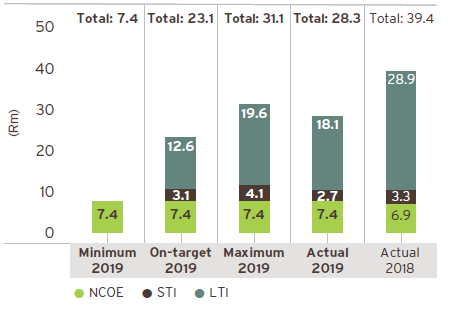 |
New exploitation strategy: An in-depth review of Exxaro’s current business strategy was required in order to respond to the business environment changes relating to coal. An optimal exploitation strategy was devised and approved by the board in line with objectives set.
Improved operational performance: Operational improvement and innovation are key drivers of Exxaro’s value creation strategy for existing operations. The P75 strategy targets statistical prior performance as benchmarks for the future and the set target for the financial year was realised by achieving three months of consecutive P62.5 of the base target. The P75 is a high-level performance standard measured by each business unit’s top 25% performance achievement on the base year. The objective is to improve performance so that we consistently perform at the top 25% levels without any capital investments by reducing variability in the processes and improving stability of our operations.
Growth strategy: The board required a comprehensive review of the Business of Tomorrow (BOT) strategy and rethinking of the future growth scenarios for Exxaro. The CEO delivered on these objectives and the board has approved the new strategic growth proposals and plans.
PA Koppeschaar
Finance director
| PA Koppeschaar: Finance director |
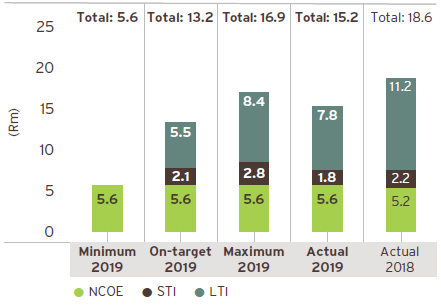 |
Implementation of community and employee ownership schemes: Exxaro’s replacement empowerment shareholding transaction was concluded in 2017 with 10% of shareholding as transfers for the benefit of Exxaro’s employees and communities adjacent to its operations. The finance director oversaw the development of an appropriate transaction structure to ensure no further dilution to shareholders, tax efficiency as well as an acceptable accounting charge. The design of the structure, consultation with internal and external stakeholders, and engagement with unions, tax and accounting sign off were all successfully completed. Final implementation, following the registration of the trust, will be completed in early 2020.
Growth: Successfully supported and contributed to the journey of implementing planned scope, second core strategy development and transition principles developed.
Innovative market-leading initiatives: The digitisation programmes at Grootegeluk that caters for modern financial reporting were successfully rolled out to enable agile decision making with less time and effort, more efficiently and accurately. During budgeting and forecasting cycles, standardised, simplified and efficient budgeting and forecasting processes have been embedded in financial, workforce and capex planning areas.
Self-service technology was successfully implemented, guided buying channels in the supply chain environment, improving the focus into execution speed, value creation, enabling insight-driven decision making, and providing professional advisory or coaching to support impactful sourcing events. The digital procurement platform is the first new cloud-based enterprise resource planning system to be implemented by Exxaro. Go-live at Belfast, Leeuwpan and FerroAlloys in 2019 and the rest of the operations will be implemented in early 2020.
Diversify funding sources: Funding for coal mining companies is scarce and expensive. Exxaro therefore decided to diversify its funding sources and not to rely on bank funding. The South African corporate bond market was tapped in 2019 and the finance director was tasked with overseeing the bond programme to ensure sufficient market appetite as well as competitive pricing. A R5 billion medium-term note programme was launched and, at the initial auction, proceeds of R1 billion were raised. The initial bond was substantially oversubscribed and the following pricing was achieved: three-year tranche (three-month JIBAR rate plus 165 basis points) and a five-year tranche
(three-month JIBAR rate plus 189 basis points). This compares favourably with Exxaro’s existing syndicated loan facility with a consortium of local banks. Under this facility, Exxaro is paying JIBAR plus w325 basis points for a five-year term and, on the seven-year facility, JIBAR plus 360 basis points.
V Balgobind
Executive head of human resources
| V Balgobind: Executive head of human resources |
 |
Culture initiative: The Exxaro culture journey is aligned with the business strategy to ensure change in workplace behaviour and to create a positive user experience for employees across our businesses. Embedding our values, culture themes, and behaviours continued in 2019.
Workforce of the future: Emphasis on future skills and competencies required to support the business strategy has been identified and defined. Training programmes have been sourced to equip employees to adapt and learn new skills to ensure capabilities are acquired to support the Exxaro strategy.
Growth: Successfully supported and contributed to the journey of implementing planned scope, second core strategy development and transition principles.
AW Diedericks
Executive head of business development
| AW Diedericks: Executive head of business development |
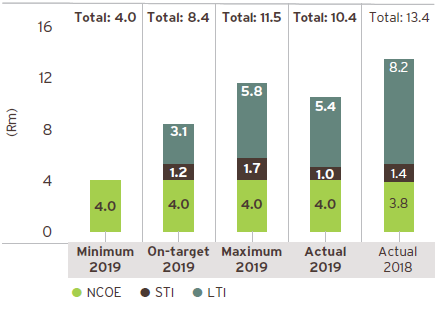 |
Strategic intent: To optimise coal operations and have a robust coal portfolio, continuous review of portfolios and execution of plans for non-robust assets within the planned timelines. The strategic intent is also to have a portfolio that is less exposed to Eskom.
Develop a strategy dashboard: The successful development, implementation and sign off by our CEO of a strategy dashboard that will assist the executive committee and the board to track the progress of the Exxaro strategy and enable the executive committee and the board to focus and prioritise the strategic actions for effective progress with strategy implementation.
Growth: Successfully supported and contributed to the journey of implementing planned scope, second core strategy development and transition principles.
JG Meyer
Executive head of projects and technology
| JG Meyer: Executive head of projects and technology |
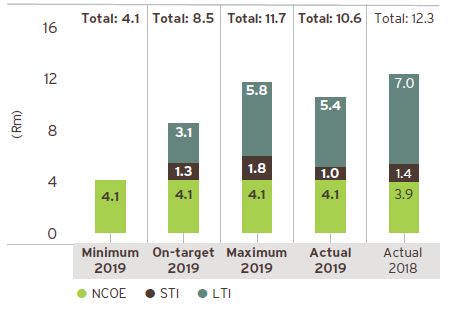 |
Strategic intent: Coal growth strategy development (functional support to the coal wings strategy and creating value presented and approved at Coal IRC).
Capital excellence process: Identifying Coal capital excellence process gaps, establishment of stay-in-business tracking and alignment with coal strategy (pre-Wings strategy) within the five-year plan.
The conneXXion: The successful move, and employee experience, was facilitated to a new head office, which was designed and constructed in line with the operational strategy and future vision, including sufficient ergonomic workspace. In addition, a smooth transition between locations was enabled to ensure minimal disruption to business operations.
Growth: Successfully supported and contributed to the journey of implementing planned scope, second core strategy development and transition principles.
MI Mthenjane
Executive head of stakeholder affairs
| MI Mthenjane: Executive head of stakeholder affairs |
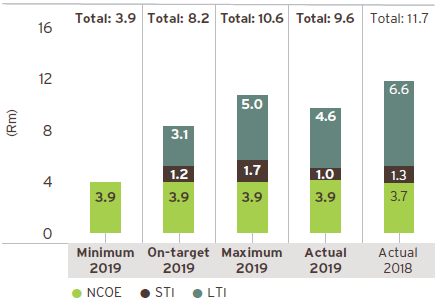 |
Shareholder shifts: Considering the challenges of climate change facing Exxaro’s coal business, Exxaro is reviewing its strategy. As the strategy evolves, stakeholders and shareholder profiles will change accordingly. The aim of this initiative is to identify the shift in the shareholder profile from the current base to a new profile of shareholders as Exxaro aligns its strategic structure and investment proposition.
Key account management (KAM) approach: KAM is a strategic approach to Exxaro’s stakeholder management with the aim of making stakeholder management a structured and enterprise-wide practice with leadership by senior management and executives.
Strategic intent: Exxaro’s impact strategy will complement Exxaro’s growth strategy and it will involve co-investing in regional development projects. Potential investors will be largely offshore and domestic impact investors. Successful signing of contracts with investors and initial activities were achieved.
Growth: Successfully supported and contributed to the journey of implementing planned scope, second core strategy development and transition principles.
N Tsengwa
Executive head of coal operations
| N Tsengwa: Executive head of coal operations |
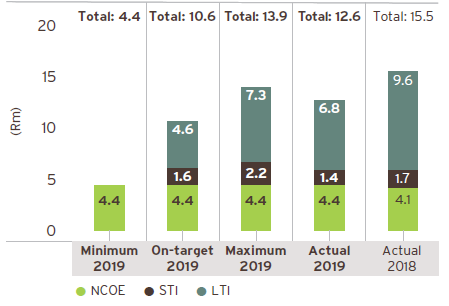 |
Startup Way methodology: Project XXX was identified as a project that would accelerate the implementation of the Startup Way methodology for Exxaro. This method is about the ability to flex fast to respond to real-life challenges and innovation to drive continuous improvement and unlock value earlier. The drive for “XXX early ROM” at Belfast has enabled us to discover and solve challenges before the committed production days and contributed to setting Belfast for success in 2020. This concept has been rolled out across all the coal business units. The objective of XXX was initially to achieve 3Mt of ROM coal. The Startup Way challenges the traditional approaches to the business and we have started to implement the principles that make modern companies successful within our own business such as early delivery of business value, quick response to change and people over processes.
Improved operational performance: P75 (coal operations) is a high-level performance standard measured by each business unit’s top 25% performance achievement on the base year. The objective is to improve performance so that we consistently perform at the top 25% levels without any capital investments by reducing variability in the processes and improving stability of our operations. A detailed study of P75 has been conducted at all operations to determine possible constraints.
Digital@Exxaro integrated operations centres (including Middle Eye): The digital journey at Exxaro includes implementing integrated operations centres across all business units to visualise and integrate performance management of our entire value chain in real time, and thus improve safety, productivity and costs. The integrated operations centres will apply data science to predict equipment failures or unwanted events, integrate Mineral Resources into real-time decision making and start building deep data learnings to automate parts of the value chain. The integrated digital management platform focuses on strategic decision making to ensure far-reaching optimisation.
Growth: Successfully supported and contributed to the journey of implementing planned scope, second core strategy development and transition principles.
SE van Loggerenberg
Company secretary
| SE van Loggerenberg: Company secretary |
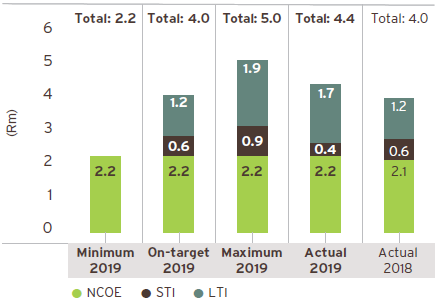 |
Piloting and rolling out voice recognition system: Exxaro’s business excellence and digitalisation strategy aims to ensure that more work can be delivered with fewer resources measured by no new full-time employees appointed to support more company secretary outputs.
Corporate governance framework support business: Exxaro’s governance strategy to ensures greater transparency and accountability, measured by tracking whether decisions are made in a more agile manner without compromising governance, measured in time to decision making.
Growth: Successfully supported and contributed to the journey of implementing planned scope, second core strategy development and transition principles.
M Veti
Executive head of sustainability
| M Veti: Executive head of sustainability |
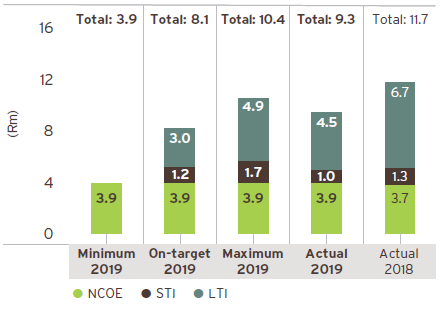 |
Matla mining right renewal: Obtain approval for renewal of mining right and execution.
Growth: Successfully supported and contributed to the journey of implementing planned scope, second core strategy development and transition principles developed.
We also disclose the outcome of the 2017 (and 2016) conditional LTIP awards that vest in April 2020 (and vested in April 2019).
Of the awards made in April 2017, 92.3% vest in April 2020. A summary showing the vesting percentages by vesting conditions for the awards are summarised in the table below.
Table 16: Performance vesting conditions outcome
| Performance vesting condition | Weight (%) | 2019 (%) |
2018 (%) |
||
|---|---|---|---|---|---|
| HEPS | 33.33 | 100.00 | 100.00 | ||
| TSR | 33.33 | 100.00 | 100.00 | ||
| ESG | 33.34 | 76.90 | 76.90 | ||
| Overall vesting | 92.30 | 92.30 |
2019 HEPS was 2 193 cps compared to the maximum vesting (100%) required at 1 572 cps.
2018 HEPS was 1 903 (cps) compared to the maximum vesting (100%) required at 563 cps.
2019 TSR was 31% and positioned 3rd (1st Anglo Platinum: 45%, 2nd Anglo American: 35%, 4th: AngloGold Ashanti: 28%, 5th BHP Billiton: 27%, 6th Impala Platinum: 22%, 7th Gold Fields: 13%, 8th Mondi: 8%, 9th Sasol: -5% and 10th
Sappi: -13%).
2018 TSR was 44% and positioned 2nd (1st Sappi: 153%, 3rd Anglo American: 36%, 4th Anglo Platinum: 24%, 5th BHP Billiton: 16%, 6th Mondi: 10%, 7th AngloGold Ashanti: 9%, 8th Sasol: 8%, 9th Gold Fields: 5% and 10th Impala
Platinum: -12%).
In both periods, a minimum of 3rd position was required to vest 100% of the TSR portion of awards.
The environmental component of ESG resulted in an achievement at threshold (30% vesting) due to a total of nine level 2 cases reported over the three-year period:
Below we detail our awards under the LTIP and DBP:
LTIP
The table below illustrates the shares held by each participant, shares exercised and shares forfeited due to performance conditions not being met in the review period.
Table 17: LTIP transaction details for executive directors and prescribed officers in 2019
| 2019 | Shares held at 31 December (Number) |
Exercisable (Period) |
Pre-tax value if exercisable at 31 December1 (R) |
Adjustment2 (Number) |
Shares exercised during the year (Number) |
Shares forfeited3 (Number) |
Sale price/ market price (R) |
Pre-tax gain (R) |
Date exercised |
|---|---|---|---|---|---|---|---|---|---|
| Executive directors | |||||||||
| MDM Mgojo | 01/04/2019 | 190 337 | 16 051 | 164.78 | 31 363 731 | 01/04/2019 | |||
| 148 289 | 01/04/2020 | 19 446 619 | 8 381 | ||||||
| 161 974 | 01/04/2021 | 21 241 270 | 9 154 | ||||||
| 111 942 | 01/04/2022 | 14 680 074 | |||||||
| 422 205 | 55 367 963 | 17 535 | 190 337 | 16 051 | 31 363 731 | ||||
| PA Koppeschaar | 01/04/2019 | 47 744 | 4 026 | 164.78 | 7 867 256 | 01/04/2019 | |||
| 01/09/2019 | 2 174 | 35 470 | 2 991 | 135.11 | 4 792 352 | 09/09/2019 | |||
| 64 366 | 01/04/2020 | 8 440 957 | 3 638 | ||||||
| 76 047 | 01/04/2021 | 9 972 804 | 4 298 | ||||||
| 52 605 | 01/04/2022 | 6 898 620 | |||||||
| 193 018 | 25 312 381 | 10 110 | 83 214 | 7 017 | 12 659 608 | ||||
| Prescribed officers | |||||||||
| V Balgobind | 01/04/2019 | 38 416 | 3 239 | 164.78 | 6 330 188 | 01/04/2019 | |||
| 01/04/2019 | 21 760 | 164.78 | 3 585 613 | 01/04/2019 | |||||
| 28 974 | 01/04/2020 | 3 799 650 | 1 638 | ||||||
| 32 148 | 01/04/2021 | 4 215 889 | 1 817 | ||||||
| 22 218 | 01/04/2022 | 2 913 669 | 0 | ||||||
| 83 340 | 10 929 208 | 3 455 | 60 176 | 3 239 | 9 915 801 | ||||
| AW Diedericks | 01/04/2019 | 49 547 | 4 178 | 164.78 | 8 164 355 | 01/04/2019 | |||
| 36 623 | 01/04/2020 | 4 802 740 | 2 070 | ||||||
| 38 687 | 01/04/2021 | 5 073 413 | 2 187 | ||||||
| 26 362 | 01/04/2022 | 3 457 113 | |||||||
| 101 672 | 13 333 266 | 4 257 | 49 547 | 4 178 | 8 164 355 | ||||
| JG Meyer | 01/04/2019 | 49 547 | 4 178 | 164.78 | 8 164 355 | 01/04/2019 | |||
| 36 623 | 01/04/2020 | 4 802 740 | 2 070 | ||||||
| 39 720 | 01/04/2021 | 5 208 881 | 2 245 | ||||||
| 27 323 | 01/04/2022 | 3 583 138 | 0 | ||||||
| 103 666 | 13 594 759 | 4 315 | 49 547 | 4 178 | 8 164 355 | ||||
| MI Mthenjane | 01/04/2019 | 48 175 | 4 062 | 164.78 | 7 938 277 | 01/04/2019 | |||
| 35 948 | 01/04/2020 | 4 714 221 | 2 032 | ||||||
| 37 975 | 01/04/2021 | 4 980 042 | 2 147 | ||||||
| 25 754 | 01/04/2022 | 3 377 380 | |||||||
| 99 677 | 13 071 643 | 4 179 | 48 175 | 4 062 | 7 938 277 | ||||
| N Tsengwa | 01/04/2019 | 41 673 | 3 514 | 164.78 | 6 866 877 | 01/04/2019 | |||
| 01/05/2019 | 24 867 | 2 097 | 162.84 | 4 049 342 | 10/05/2019 | ||||
| 54 179 | 01/04/2020 | 7 105 034 | 3 062 | ||||||
| 58 762 | 01/04/2021 | 7 706 049 | 3 321 | ||||||
| 40 991 | 01/04/2022 | 5 375 560 | 0 | ||||||
| 153 932 | 20 186 643 | 6 383 | 66 540 | 5 611 | 10 916 219 | ||||
| SE van Loggerenberg | 01/04/2019 | 8 682 | 732 | 164.78 | 1 430 620 | 01/04/2019 | |||
| 6 562 | 01/04/2020 | 860 541 | 371 | ||||||
| 7 630 | 01/10/2020 | 1 000 598 | 432 | ||||||
| 16 187 | 01/04/2021 | 2 122 763 | 915 | ||||||
| 11 146 | 01/04/2022 | 1 461 686 | |||||||
| 41 525 | 5 445 588 | 1 718 | 8 682 | 732 | 1 430 620 | ||||
| M Veti | 01/04/2019 | 47 968 | 4 045 | 164.78 | 7 904 167 | 01/04/2019 | |||
| 35 456 | 01/04/2020 | 4 649 700 | 2 004 | ||||||
| 37 455 | 01/04/2021 | 4 911 849 | 2 117 | ||||||
| 25 402 | 01/04/2022 | 3 331 218 | |||||||
| 98 313 | 12 892 767 | 4 121 | 47 968 | 4 045 | 7 904 167 |
| 1 | Based on a share price of R131.14 which prevailed on 31 December 2019. |
| 2 | An adjustment was made as per 2017 remuneration committee approval related to Tronox transaction. |
| 3 | Shares forfeited due to performance conditions not being fully met. |
DBP
No further performance conditions apply to this scheme other than continued employment at the time of vesting.
The table below illustrates the shares held by each participant as well as shares exercised and shares forfeited as a result of resignations in the review period.
Table 18: DBP transaction details for executive directors and prescribed officers in 2019
| 2019 | Shares held at 31 December (Number) |
Exercisable (Period) |
Pre-tax value if exercisable at 31 December1 (R) |
Adjustment2 (Number) |
Shares exercised during the year (Number) |
Sale price/ market price (R) |
Pre-tax gain (R) |
Date exercised |
|---|---|---|---|---|---|---|---|---|
| Executive directors | ||||||||
| MDM Mgojo | 04/03/2019 | 6 314 | 152.57 | 963 327 | 20/03/2019 | |||
| 31/03/2019 | 11 444 | 164.78 | 1 885 742 | 01/04/2019 | ||||
| 31/08/2019 | 91 | 1 598 | 135.11 | 215 906 | 09/09/2019 | |||
| 1 209 | 31/08/2020 | 158 548 | 69 | |||||
| 4 372 | 09/03/2021 | 573 344 | 248 | |||||
| 11 139 | 31/03/2021 | 1 460 768 | 630 | |||||
| 1 003 | 31/08/2021 | 131 533 | 57 | |||||
| 1 414 | 15/03/2022 | 185 432 | ||||||
| 8 347 | 31/03/2022 | 1 094 626 | ||||||
| 27 484 | 3 604 251 | 1 095 | 19 356 | 3 064 975 | ||||
| PA Koppeschaar | 732 | 31/08/2021 | 95 994 | 42 | ||||
| 5 369 | 31/03/2022 | 704 091 | ||||||
| 6 101 | 800 085 | 42 | ||||||
| Prescribed officers | ||||||||
| V Balgobind | 04/03/2019 | 1 836 | 152.57 | 280 119 | 26/03/2019 | |||
| 31/03/2019 | 2 040 | 164.78 | 336 151 | 01/04/2019 | ||||
| 31/08/2019 | 24 | 410 | 135.11 | 55 395 | 09/09/2019 | |||
| 1 054 | 09/03/2020 | 138 222 | 60 | |||||
| 1 891 | 31/03/2020 | 247 986 | 107 | |||||
| 303 | 31/08/2020 | 39 735 | 18 | |||||
| 1 089 | 09/03/2021 | 142 811 | 62 | |||||
| 1 880 | 31/03/2021 | 246 543 | 107 | |||||
| 253 | 31/08/2021 | 33 178 | 15 | |||||
| 351 | 15/03/2022 | 46 030 | ||||||
| 2 540 | 31/03/2022 | 333 096 | ||||||
| 9 361 | 1 227 601 | 393 | 4 286 | 671 665 | ||||
| AW Diedericks | 04/03/2019 | 3 650 | 152.57 | 556 881 | 19/03/2019 | |||
| 31/03/2019 | 5 339 | 164.78 | 879 760 | 09/04/2019 | ||||
| 31/08/2019 | 53 | 922 | 135.11 | 124 571 | 10/09/2019 | |||
| 2 406 | 09/03/2020 | 315 523 | 136 | |||||
| 4 368 | 31/03/2020 | 572 820 | 247 | |||||
| 688 | 31/08/2020 | 90 224 | 39 | |||||
| 2 484 | 09/03/2021 | 325 752 | 141 | |||||
| 4 287 | 31/03/2021 | 562 197 | 243 | |||||
| 557 | 31/08/2021 | 73 045 | 32 | |||||
| 773 | 15/03/2022 | 101 371 | ||||||
| 3 098 | 31/03/2022 | 406 272 | ||||||
| 18 661 | 2 447 204 | 891 | 9 911 | 1 561 212 | ||||
| JG Meyer | 31/08/2019 | 53 | 928 | 135.11 | 125 382 | 03/09/2019 | ||
| 2 413 | 09/03/2020 | 316 441 | 137 | |||||
| 4 375 | 31/03/2020 | 573 738 | 248 | |||||
| 688 | 31/08/2020 | 90 224 | 39 | |||||
| 7 476 | 980 403 | 477 | 928 | 125 382 | ||||
| MI Mthenjane | 1 304 | 09/03/2020 | 171 007 | 74 | ||||
| 670 | 31/08/2020 | 87 864 | 38 | |||||
| 1 346 | 09/03/2021 | 176 514 | 77 | |||||
| 2 331 | 31/03/2021 | 305 687 | 132 | |||||
| 5 651 | 741 072 | 321 | ||||||
| N Tsengwa | 31/03/2019 | 2 596 | 164.78 | 427 769 | 09/04/2019 | |||
| 31/08/2019 | 27 | 466 | 135.11 | 62 961 | 10/09/2019 | |||
| 1 308 | 09/03/2020 | 171 531 | 74 | |||||
| 396 | 31/08/2020 | 51 931 | 23 | |||||
| 265 | 31/08/2021 | 34 752 | 15 | |||||
| 519 | 15/03/2022 | 68 062 | ||||||
| 2 359 | 31/03/2022 | 309 359 | ||||||
| 4 847 | 635 635 | 139 | 3 062 | 490 730 | ||||
| M Veti | 31/08/2019 | 29 | 499 | 135.11 | 67 420 | 10/09/2019 | ||
| 1 271 | 09/03/2020 | 166 679 | 72 | |||||
| 369 | 31/08/2020 | 48 391 | 21 | |||||
| 1 326 | 09/03/2021 | 173 892 | 75 | |||||
| 2 314 | 31/03/2021 | 303 458 | 131 | |||||
| 302 | 31/08/2021 | 39 604 | 18 | |||||
| 419 | 15/03/2022 | 54 948 | ||||||
| 1 675 | 31/03/2022 | 219 660 | ||||||
| 7 676 | 1 006 632 | 346 | 499 | 67 420 |
| 1 | Based on a share price of R131.14 which prevailed on 31 December 2019. |
| 2 | An adjustment was made as per 2017 remuneration committee approval related to Tronox transaction. |
Table 19: DBP income for executive directors and prescribed officers
| DBP shares held as a percentage of NCOE at 31 Dec 2019 (%) |
DBP shares held at 31 Dec 2019 (R) |
DBP shares held at 31 Dec 2019 (Number) |
2016 DBP shares matched (R) |
2016 DBP shares matched (Number) |
||
|---|---|---|---|---|---|---|
| MDM Mgojo | 49 | 3 604 251 | 27 484 | 3 064 975 | 19 356 | |
| PA Koppeschaar | 14 | 800 085 | 6 101 | – | – | |
| V Balgobind | 36 | 1 227 601 | 9 361 | 671 665 | 4 286 | |
| AW Diedericks | 61 | 2 447 204 | 18 661 | 1 561 212 | 9 911 | |
| JG Meyer | 24 | 980 403 | 7 476 | 125 382 | 928 | |
| MI Mthenjane | 19 | 741 072 | 5 651 | – | – | |
| Dr N Tsengwa | 15 | 635 635 | 4 847 | 490 730 | 3 062 | |
| M Veti | 26 | 1 006 632 | 7 676 | 67 420 | 499 | |
| SE van Loggerenberg | 0 | 0 | 0 | 0 | 0 |
The total single figure remuneration (King IVTM) for the executive directors and prescribed officers is stated below in Table 20, to align with King IVTM disclosure. The 2019 LTIP reflected, the 1 April 2017 LTIP award that will vest as a result of 2019 performance on 1 April 2020. Since the portion of the DBP voluntary deferral is included under the STIs, proceeds from the matched portion of the DBPs are reflected under LTIs.
Table 20: Single figure remuneration as per King IVTM for 2019 and 2018
| Year | NCOE (R) |
Recognition and other payments (R) |
STIs (R) |
LTIs (R) |
Total remuneration (R) |
|
| Executive directors | ||||||
| MDM Mgojo | 2019 | 7 410 601 | 5 260 | 2 741 922 | 18 107 777 | 28 265 560 |
| 2018 | 6 933 519 | 200 240 | 3 321 854 | 28 919 766 | 39 375 379 | |
| PA Koppeschaar | 2019 | 5 624 332 | 5 260 | 1 799 786 | 7 791 003 | 15 220 381 |
| 2018 | 5 163 873 | 10 760 | 2 215 820 | 11 205 607 | 18 596 060 | |
| Prescribed officers | ||||||
| V Balgobind | 2019 | 3 363 889 | 5 260 | 840 972 | 3 933 020 | 8 143 141 |
| 2018 | 3 135 624 | 6 956 | 1 126 004 | 8 657 415 | 12 925 999 | |
| AW Diedericks | 2019 | 4 004 844 | 5 260 | 1 001 211 | 5 411 496 | 10 422 811 |
| 2018 | 3 818 186 | 5 260 | 1 371 114 | 8 195 845 | 13 390 405 | |
| JG Meyer | 2019 | 4 141 399 | 5 260 | 1 035 350 | 5 413 332 | 10 595 341 |
| 2018 | 3 895 210 | 5 260 | 1 398 774 | 6 957 358 | 12 256 602 | |
| MI Mthenjane | 2019 | 3 916 983 | 55 575 | 979 246 | 4 610 097 | 9 561 901 |
| 2018 | 3 747 913 | 6 260 | 1 345 878 | 6 647 368 | 11 747 419 | |
| Dr N Tsengwa | 2019 | 4 373 844 | 10 760 | 1 399 630 | 6 781 408 | 12 565 642 |
| 2018 | 4 070 181 | 69 942 | 1 746 518 | 9 599 941 | 15 486 582 | |
| SE van Loggerenberg | 2019 | 2 244 531 | 10 760 | 448 906 | 1 717 831 | 4 422 028 |
| 2018 | 2 092 998 | 21 310 | 646 948 | 1 197 969 | 3 959 225 | |
| M Veti | 2019 | 3 863 424 | 5 260 | 965 856 | 4 506 743 | 9 341 283 |
| 2018 | 3 696 666 | 6 260 | 1 327 476 | 6 683 662 | 11 714 064 |
The STIs are inclusive of the voluntary individual deferral made for 2019.
The LTIP reflects 92.3% of the April 2017 award that will vest on 1 April 2020 at 31 December 2019 closing share price.
For 2019:
The amount of R5 260 includes recognition payments: R2 500 for fatality free recognition and R2 760 for LTIFR recognition.
Additional amounts of R5 500 for suggestion award were received by N Tsengwa and SE van Loggerenberg to total R10 760.
Leave encashment amount are included for M Mthenjane: R50 315.
For 2018:
The amount of R5 260 includes recognition payments: R2 500 for fatality free recognition and R2 760 for LTIFR recognition.
Long-service cash awards of R1 000 are included for: N Tsengwa, M Mthenjane and M Veti.
An amount of R10 550 is included for SE van Loggerenberg for long-service award.
Leave encashment amounts are included for M Mgojo: R194 980, V Balgobind: R1 696 and N Tsengwa: R60 941.
Details are provided by name and role for the review period and 2019 with explanations where necessary.
The associated fees were set in line with the policy. Increases to rates applied were 7% (2019) compared to 6.5% (2018).
Table 21: Non-executive directors’ remuneration
| 2019 | 2018 | ||||||
|---|---|---|---|---|---|---|---|
| Fees for services R |
Benefits and allowances R |
Total R |
Fees for services R |
Benefits and allowances R |
Total R |
||
| Non-executive directors | |||||||
| GJ Fraser-Moleketi | 938 235 | 5 478 | 943 713 | 452 448 | 6 164 | 458 612 | |
| MW Hlahla1 | 600 413 | 0 | 600 413 | 430 791 | 0 | 430 791 | |
| D Mashile-Nkosi2 | 414 415 | 0 | 414 415 | 351 335 | 1 100 | 352 435 | |
| L Mbatha | 702 899 | 0 | 702 899 | 454 453 | 9 641 | 464 094 | |
| VZ Mntambo | 638 068 | 0 | 638 068 | 582 452 | 0 | 582 452 | |
| MJ Moffett | 923 063 | 0 | 923 063 | 429 745 | 0 | 429 745 | |
| LI Mophatlane | 1 045 616 | 2 913 | 1 048 529 | 618 419 | 4 841 | 623 260 | |
| EJ Myburgh | 1 168 912 | 0 | 1 168 912 | 818 481 | 17 503 | 835 984 | |
| V Nkonyeni | 956 784 | 21 879 | 978 663 | 767 230 | 18 275 | 785 505 | |
| J van Rooyen (chairman) | 2 016 072 | 0 | 2 016 072 | 1 494 465 | 0 | 1 494 465 | |
| A Sing | 787 867 | 0 | 787 867 | 566 327 | 2 410 | 568 737 | |
| PCCH Snyders | 1 041 060 | 55 472 | 1 096 532 | 751 525 | 70 633 | 822 158 | |
| Total non-executive director remuneration | 11 233 404 | 85 742 | 11 319 146 | 9 076 625 | 141 931 | 9 218 556 | |
| 1 | Resigned on 31 December 2019. |
| 2 | Resigned on 11 October 2019 |